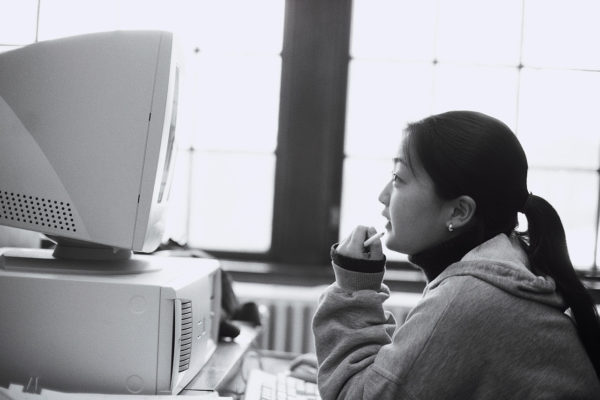
Schools with one-to-one computing programs have fewer discipline problems, lower dropout rates, and higher rates of college attendance than schools with a higher ratio of students to computers, according to the results of a major new study. But for one-to-one programs to boost student achievement as well, they must be properly implemented, the study found.
Sixty-nine percent of the schools in the study reported that their students’ achievement scores on high-stakes tests were on the rise. Among schools with 1-to-1 computing programs, that figure was 70 percent. But it was 85 percent for schools with 1-to-1 computing programs that employed certain strategies for success, including electronic formative assessments on a regular basis and frequent collaboration of teachers in professional learning communities.
The findings come from Project RED (Revolutionizing Education), a national initiative that aims to prove that when properly implemented, investing in technology can boost student achievement and will result in monetary savings for schools and local governments. The survey results will be revealed June 28 at the annual International Society for Technology in Education (ISTE) conference [Editor’s Note: For more live coverage of this year’s ISTE conference, go to: http://www.eschoolnews.com/events/conferences/necciste/].
The study is believed to be the largest full-scale look at how technology is being used in schools, and what factors lead to the greatest success in education technology.
Researchers surveyed nearly a thousand schools with diverse student populations and varying levels of technology integration. Using a regressive model of statistical analysis, they correlated 11 measures of success (such as dropout rates, discipline rates, and student achievement scores) with more than 100 independent variables across 22 categories to determine which factors had the biggest impact on success.
Results indicate that schools properly implementing 1-to-1 programs achieve more educational success than schools with higher student-to-computer ratios.
“In our practice, we see how personalization and individualization of instruction work best when students have 100-percent access to a computing device,” said Leslie Wilson, president of the One-to-One Institute, a nonprofit organization focused on professional development for technology integration and a co-author of the study.
Leadership and vision are two essential components in technology implementation, the study found, and while all schools can benefit from technology, the study shows that “when principals receive specializing training and technology [is] properly implemented, the benefits increase even more,” according to Project RED.
In fact, a strong principal and strong district leadership are among the most important variables when it comes to implementing education technology and transforming schools, which suggests that change management training is especially important for principals involved in large-scale technology implementations.
“It seems that when the whole rest of the world is using technology to enhance processes, in education we’re not getting that traction, [and it is] particularly frustrating,” said Eileen Lento, education strategist for Intel. “It’s clear now that we have to improve educational outcomes, and in some cases we can’t do that without technology.”
Implementation factors
“The most exciting findings were identification of which implementation factors improve learning outcomes,” said Tom Greaves, CEO of the Greaves Group and founder of the initiative.
Daily technology use in core subject-area classes, frequent technology use in intervention courses, and a low student-to-computer ratio were found to play a critical role in reducing dropout rates, the study reveals. Principal leadership and training also were important factors.
“Students in reading intervention, special education, [and] Title 1 [programs] … benefit from the individualized instruction that technology can provide best,” according to Project RED.
In fact, if schools can afford to make only one key investment in education technology, it should be infusing their intervention classes with technology, the study results suggest. Technology-infused intervention programs were the top predictor for improved high-stakes test scores, lower dropout rates, and improved discipline, Project RED said. The only other top predictor for more than one measure of educational success was a low student-to-computer ratio.
“I was really pleased that the tech-infused intervention classes scored so highly in almost all the academic outcomes,” said Jeanne Hayes, president of the Hayes Connection and a co-author on the study. “I see, daily, [those programs] getting cut because of budget problems.”
Among all school surveyed, 50 percent say they are seeing a reduction in student disciplinary actions, and 56 percent of their students plan to attend college. Among schools with 1-to-1 computing programs, these figures are 65 percent and 66 percent, respectively. But for schools with 1-to-1 programs that report using proper implementation strategies, including regular formative assessment and teacher collaboration, these figures jump to 82 percent and 86 percent.
In general, schools with lower student-to-computer ratios have better measurable results than schools with higher ratios. But still, too few schools are taking full advantage of their ed-tech investments.
“Very few schools implement many of [the] key implementation factors, despite large investments in infrastructure and hardware,” Project RED said.
For instance, researchers found that not one school with a 1-to-1 student-to-computer ratio deployed all of the key implementation factors.
“Schools with devices can help students learn, but proper implementation drives even greater gains,” said Michael Gielniak, director of programs and development for the One-to-One Institute. “These findings are particularly significant, in light of the national agenda for education reform.”
Frequency of use is important
While technology can have a lasting impact, the frequency of its use is vital to that impact.
“The daily use of technology in core classes correlates highly to desirable education success measures,” Project RED said. “Daily technology use was one of the top five indicators of better discipline, better attendance, and increased college attendance.”
Among schools with 1-to-1 computing programs, daily technology use in core classes ranged from 57 percent to 62 percent. “Unfortunately, many schools reported using the technology only weekly or less frequently for many classes,” the researchers said.
Lento suggested this underutilization might be a reflection of too little professional development, both for teachers and school leaders. Professional development is important not just for educators in knowing how to use technology effectively in their classes, but also for administrators in leading transformational change in their schools.
Social media use also has an impact
Collaboration and social media are increasingly important as 21st-century skills become key factors in college and workplace success.
“Web 2.0 social media substantially enhance collaboration productivity, erasing the barriers of time, distance, and money,” Project RED said. “Collaboration can now extend beyond the immediate circle of friends to include mentors, tutors, and experts worldwide. Real-time collaboration increases student engagement, one of the critical components for student success.”
Team members “were thrilled” with the effects of social media use reflected in the report, Hayes said. “If you think about how kids operate, they’ve always wanted to communicate with each other. So the fact that technology can help us” is encouraging, she added.
Sixty-five percent of responding schools that use social media saw a drop in disciplinary action, versus 56 percent of schools not using social media. More than half (52 percent) saw a reduction in dropout rates, whereas just 37 percent of schools not using social media saw a dropout rate reduction.
An entire chapter in the report will focus on school best practices, Hayes said, and that chapter will be offered free of charge to any school that wants it. The full report will be available in August. The survey elicited 997 responses, 227 of which came from 1-to-1 schools.
Intel is Project RED’s lead sponsor, and the initiative has received additional support from Apple, the Pearson Foundation, Qwest, and eChalk.
“It would be my hope that we seize this opportunity to really drive transformation,” Lento said, adding that education reformers can learn lessons from other areas, such as health-care reform, because some of the technological challenges such as privacy and interoperability are the same.
“I think we need to grab this opportunity and really recognize that we are investing in our future when we invest in these students, and this is a very serious need for us as a nation.”
Link:
- Friday 5: Virtual field trips - April 26, 2024
- Google, MIT RAISE launch no-cost AI training course for teachers - April 26, 2024
- 4 ways to support work-based learning - April 23, 2024



Comments are closed.